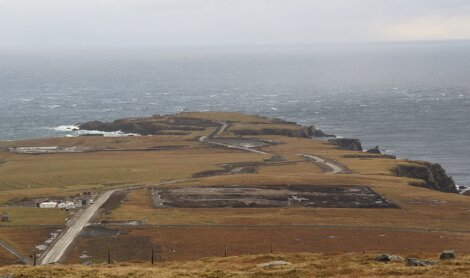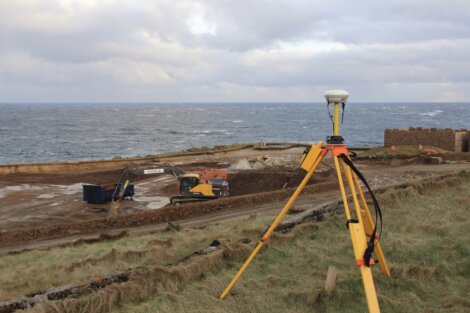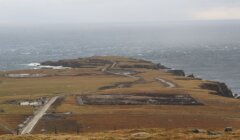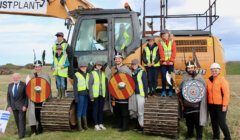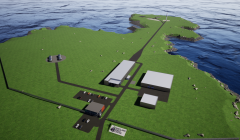News / Space industry catalyst for North Isles regeneration – Strang
Space port chief upbeat about being ahead in the race to host the first UK vertical rocket launch into space. Frank Strang also responds to concerns about the military’s role at SaxaVord Spaceport
CONSTRUCTING the SaxaVord satellite launch station in one of the remotest corners of Shetland, and indeed the UK, is already contributing to the regeneration of Unst and the whole of the North Isles.
Chief executive of SaxaVord Spaceport Frank Strang told Shetland News during a site visit earlier this month that the company already employs as many as 60 people while a further 40 or so are working on the construction site at Lamba Ness.
He said growing confidence in what was happening at Saxa Vord meant that people had started to return Unst for employment opportunities, a view echoed by project manager Elizabeth Johnson who said there was a lot of support in the community for the project.
The space centre is widely expected to host the UK’s first vertical rocket launch into space. Saxa Vord is also hosting the much-heralded launch of the UK Space Agency’s pathfinder project, delivered by Lockheed Martin and ABL Systems. This launch project initially scheduled for 2022 is now likely to happen later in 2023.
During a wide-ranging interview with SaxaVord’s chief executive, Strang said the space centre had the potential to replace all that was lost when the Royal Air Force withdrew from Saxa Vord in the early 2000s.
And he addressed concern in some sectors of the Shetland community that the space port had an undisclosed military purpose and, in addition, could make Shetland a potential target in the case of a military conflict.
“The benefit of the space port to the North Isles, and not just Unst, will be as significant as when the RAF was here,” Strang said.
He and his wife Debbie bought the former Saxa Vord camp in 2006 after it had been vacated by the Royal Air Force.
Become a member of Shetland News
“There difference is that you have an international business coming in that is more like oil and gas (…) and it already is making a difference,” Strang continued saying.
“People are coming back, we are employing lots of local companies, the benefits are already being felt.
“The benefits are already here, and we haven’t got going yet. Once the space port is fully operational there will be between 100 and 150 full-time jobs here at the camp.”
He said that so for £23 million had been spent on the project including several millions into upgrading the roads network to gain access to such a remote site.
Rocks and aggregate for the civil engineering work have been shipped on barges from Norway to Baltasound’s pier, from where it is taken on trucks to the construction site.
Strang said it had been “substantially cheaper” to bring in the aggregate that way rather than sourcing stones from Shetland mainland. Further shipments from Norway are expected.
There are also plans to extend the runway of the airfield at Baltasound and to bring the airport back to life.
“Because of the lack of infrastructure, we are looking to bring the airport back online, and will be putting in a planning application to extend the runway so that our clients and visitors can fly straight in,” the chief executive said.
“Remember, back in 1994/95 around 350,000 passengers a year went through that airfield, so this is nothing new.
“We can bring it back and space will be the catalyst for that.”
North Isles councillor Ryan Thomson confirmed that after some initial reservation there was now a sense of optimism in the community and the general hope that the venture would “take off”.
Huge international interest
Strang said the space port, which is being built is several phases, will become an integral part of the developing UK and global space economy.
And he revealed that the company was in contract negotiations with seven different international launch providers, with a lot of further interest shown from other countries.
He said he remained confident that in about three to four years, the Lamba Ness site could host as many as 30 launches a year, each loaded with between 10 to 15 satellites from a wide range of customers.
With space based operations affecting many aspects of daily life, the growth potential for this relatively new industry appears to be vast. By 2030 forecasts predict that between 100,000 and 150,000 satellites could be orbiting earth. That is a 20-fold increase from what is out there today.
Some forecasters have suggested the global space industry could be worth over $1 trillion by 2040, with the UK aiming to capture as much as 10 per cent of that market by the end of the decade.
Strang said that “probably” between 60 and 70 per cent of SaxaVord’s business will be commercial with the remaining coming from government but “not necessarily military”.
He added he would welcome the military as a customer and was adamant that neither the military nor the UK Government had a stake in the space port.
“The space port is totally privately owned. If the military were to come to us, they would be coming as a client of a launch provider just like any other customers.”
He said he “personally would welcome military clients” and pointed out that satellites very often had a “dual” use and hence the borderlines between commercial and military were often blurred.
“Satellites are used for earth observation, for monitoring disaster relief, wildfires, and the Ukraine is a classic example how satellite technology has helped the country going,” he said, adding that the community in Unst always has had a close relationship with the military.
Referring to the RAF radar station on top of Saxa Vord hill, he added: “The military are here already. (…) The military haven’t got a stake in the site, they could be a customer, it is not confirmed but there is a definite interest, of course there is.”
Asked why the space industry usually shies away from being open about its relationship with the military, Strang said keyboard warriors on social media were treating the military as an “easy horse to whip”.
“And there is always an assumption that because something has a relation with military it is bad”.
“I saw a comment by one of the councillors that Shetland might be more of a target because of the spaceport. But Shetland is already a target to Russia because there are sites such as Sullom Voe Terminal and Shetland Gas Plant.
“If we were to be at war with Russia, I can guarantee you the first places in Shetland that would be taken out would be the oil and the gas terminals.
“And that radar on the hill [at Saxa Vord] is one of the reasons why Shetland is protected.
“So, if the space port has a relationship with the military, which it doesn’t have at the moment, I say that would be a good thing as it would help keep Shetland secure.”
Become a member of Shetland News
Shetland News is asking its many readers to consider paying for membership to get additional features and services: -
- Remove non-local ads;
- Bookmark posts to read later;
- Exclusive curated weekly newsletter;
- Hide membership messages;
- Comments open for discussion.
If you appreciate what we do and feel strongly about impartial local journalism, then please become a member of Shetland News by either making a single payment, or setting up a monthly, quarterly or yearly subscription.






